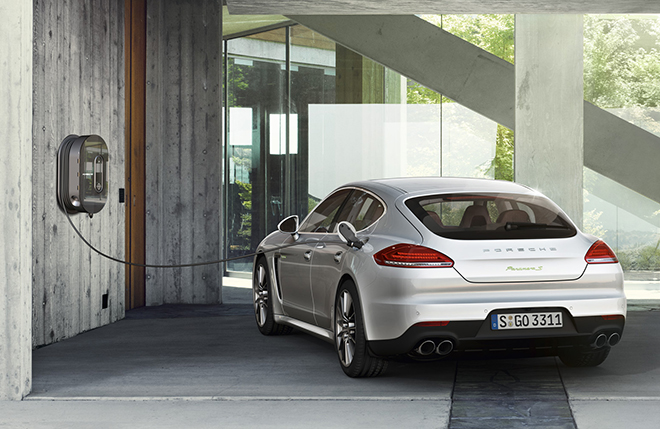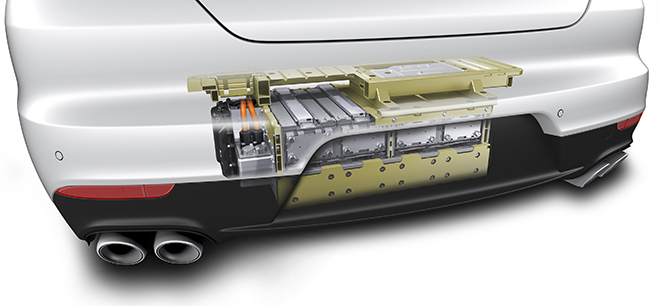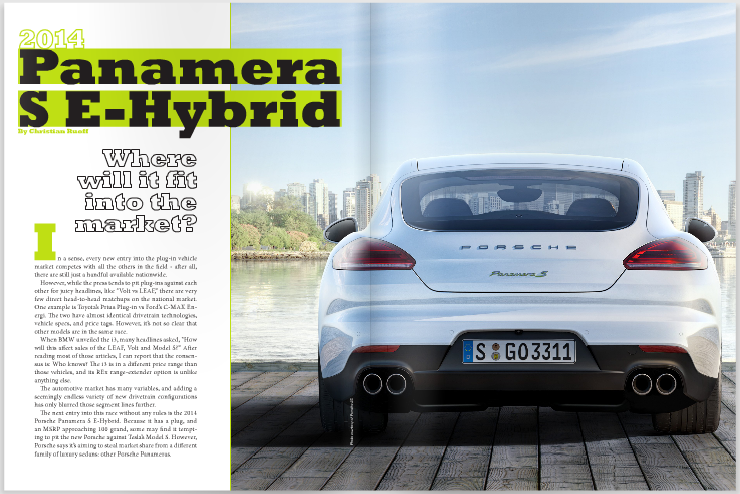In a sense, every new entry into the plug-in vehicle market competes with all the others in the field – after all, there are still just a handful available nationwide.
However, while the press tends to pit plug-ins against each other for juicy headlines, like “Volt vs LEAF,” there are very few direct head-to-head matchups on the national market. One example is Toyota’s Prius Plug-in vs Ford’s C-MAX Energi. The two have almost identical drivetrain technologies, vehicle specs, and price tags. However, it’s not so clear that other models are in the same race.
When BMW unveiled the i3, many headlines asked, “How will this affect sales of the LEAF, Volt and Model S?” After reading most of those articles, I can report that the consensus is: Who knows? The i3 is in a different price range than those vehicles, and its REx range-extender option is unlike anything else.
The automotive market has many variables, and adding a seemingly endless variety of new drivetrain configurations has only blurred those segment lines further.
The next entry into this race without any rules is the 2014 Porsche Panamera S E-Hybrid. Because it has a plug, and an MSRP approaching 100 grand, some may find it tempting to pit the new Porsche against Tesla’s Model S. However, Porsche says it’s aiming to steal market share from a different family of luxury sedans: other Porsche Panameras.

Plugged in to power
The new plug-in model incorporates dramatic improvements over the hybrid model that it’s replacing. The Panamera S E-Hybrid’s electric drive produces 95 hp with a 9.4 kWh Li-ion battery pack, compared to 34 hp and a 1.7 kWh nickel-metal hydride pack in the old standard hybrid.
In Porsche terms, “S” designates a higher performance model, and the S E-Hybrid combines the 95 hp electric drive with a 333 hp supercharged V6 engine for a total of 416 hp.

“We really think that any Panamera customer could be a buyer for this product,” Porsche’s eMobility Project Manager Trent Warnke told Charged. “Any customer who is coming in to look for that higher-level Panamera S performance could want this car, because it’s got almost the exact same performance [as the S gas version] and it gives you a lot more benefits.”
The two models have very similar specs:
- The Panamera S (gas version) starts at $93,200, has 420 hp, does 0-60 mph in 4.9 seconds, and has a top speed of 178 mph.
- The Panamera S E-Hybrid starts at $99,000, has 416 hp, does 0-60 mph in 5.2 seconds, and has a top speed of 167 mph.
Taking the federal tax credit into consideration brings the price tags even closer together. The PHEV is expected to qualify for a $4751.60 credit, which is based on the size of its battery, bringing the price down to $94,248.40.
Although the plug-in version has slightly less horsepower, the extra low-end torque of the electric motor adds a welcome boost of instant acceleration. “Right away, when you launch the car from a stop, the Panamera S E-Hybrid feels faster,” said Warnke. “All the low-end torque really sets you off the line quick.”

It has virtually the same price tag and drivability as the Panamera S, but the new PHEV also has the long list of benefits that comes with plugging in. That list, which Charged readers are very familiar with, begins with substantially fewer trips to the gas station. The Panamera S E-Hybrid hasn’t been officially rated by the EPA yet, but Porsche expects it to receive an all-electric range rating of around 20 miles (with an all-electric top speed of about 83 mph) and “significantly” better gas mileage than the Panamera S (rated for 27 mpg highway). In addition to the federal tax credits, many markets offer state and city incentives, and some utility companies have rebates for installing residential charging equipment. There are also reduced emissions, coveted HOV lane access, and nearly-silent operating modes. The list goes on and on and, all other things equal, a plug-in hybrid vehicle is simply the more dynamic choice.
“We are Porsche, so we always push performance,” said Warnke. “But with this car you get all the added side effects. So that’s why we’re really not aiming at any specific market, other than our current Panamera market. We think it really fits that buyer. It’s kind of a thrilling contradiction. On one end you can drive all-electric and be very environmentally-conscious, and on the other end you can put the pedal to the floor and summon 416 hp to do 0-60 in 5.2 seconds. It’s a lot of fun to drive, and has all those really cool Porsche characteristics.”

The features
Porsche’s first attempt at a plug-in has some unique features that have not yet been seen in any other PHEVs.
 When the battery is charged, the vehicle is in E-Power Mode, and will try to maximize all-electric driving. The accelerator pedal includes a “pressure point” that allows the driver to feel the extent of the electric capabilities. “When you’re in E-Power Mode and you push the pedal, it’s going to get to a point where it’s harder to push,” said Warnke. “Kickdown, we call it – like a kickdown on an old automatic transmission. You know if you push the pedal harder through that point, it will turn the engine on.” It’s what engineers call haptic feedback, or tactile feedback technology, that takes advantage of our sense of touch in the user interface. There is also a meter in the gauge cluster that indicates the electric power usage, but the kickdown switch allows the driver to optimize the electric capabilities without looking at the meters.
When the battery is charged, the vehicle is in E-Power Mode, and will try to maximize all-electric driving. The accelerator pedal includes a “pressure point” that allows the driver to feel the extent of the electric capabilities. “When you’re in E-Power Mode and you push the pedal, it’s going to get to a point where it’s harder to push,” said Warnke. “Kickdown, we call it – like a kickdown on an old automatic transmission. You know if you push the pedal harder through that point, it will turn the engine on.” It’s what engineers call haptic feedback, or tactile feedback technology, that takes advantage of our sense of touch in the user interface. There is also a meter in the gauge cluster that indicates the electric power usage, but the kickdown switch allows the driver to optimize the electric capabilities without looking at the meters.

When the battery runs low on usable energy, the vehicle will operate in Hybrid Mode like a standard hybrid. Basically, it maintains the battery at a minimum charge level – stopping and starting the engine at rest and during coasting, and doing some electric driving when the power is available.
There is also an E-Charge Mode that will charge the battery during driving. “In this mode you can actually charge the battery using the gas engine as you’re driving at highway speeds,” explained Warnke. “When you push E-Charge it will run the engine a little harder and charge the battery with the extra energy at about two percent per minute. So, it will fully charge the battery in about 40 minutes of driving on the highway.”

 The 9.4 kWh battery is liquid cooled and heated, and can recharge from empty in about 2.5 hours at 240 V. A Porsche-designed 3.6 kW Level 2 charger is included in the base price of the vehicle. The charging unit has two swappable cords, one for Level 1 and one for Level 2, and Warnke reports that future plug-in vehicles from Porsche will have onboard chargers capable of higher rates.
The 9.4 kWh battery is liquid cooled and heated, and can recharge from empty in about 2.5 hours at 240 V. A Porsche-designed 3.6 kW Level 2 charger is included in the base price of the vehicle. The charging unit has two swappable cords, one for Level 1 and one for Level 2, and Warnke reports that future plug-in vehicles from Porsche will have onboard chargers capable of higher rates.
The market
In May 2013, Porsche celebrated the 100,000th Panamera produced in its Leipzig, Germany factory since its launch in 2009. That milestone vehicle was a Panamera S E-Hybrid in “rhodium-silver metallic.”
 The new PHEV is replacing the Panamera S Hybrid, and beginning with the 2014 model line only the plug-in version will be available. Automotive News Europe reported that Porsche is forecasting about 10,000 unit sales over the S E-Hybrid’s life cycle, which represents about double that of the company’s first-generation hybrid, and about 10 percent of all Panamera sales. Talking to Charged, Warnke didn’t comment on exact production figures, but he did confirm that “we’re trying to penetrate more of the market than we do with our current hybrid…and we don’t think that will be a problem, because the Panamera S E-Hybrid is a significantly quicker product.”
The new PHEV is replacing the Panamera S Hybrid, and beginning with the 2014 model line only the plug-in version will be available. Automotive News Europe reported that Porsche is forecasting about 10,000 unit sales over the S E-Hybrid’s life cycle, which represents about double that of the company’s first-generation hybrid, and about 10 percent of all Panamera sales. Talking to Charged, Warnke didn’t comment on exact production figures, but he did confirm that “we’re trying to penetrate more of the market than we do with our current hybrid…and we don’t think that will be a problem, because the Panamera S E-Hybrid is a significantly quicker product.”
The S E-Hybrid will be in US dealerships at the end of November, and the company is currently taking pre-orders from Porsche fans who can’t wait to plug in.
The 2014 Porsche Cayenne is also available as an S Hybrid, and while the company has made no official announcement about upgrading it to a plug-in hybrid, the Internet is full of speculation and quotes from company insiders about that possibility. We think it’s safe to assume the Cayenne will go the way of the Panamera and announce that it’s plugging in its hybrid within the next year. The company is also planning limited production of the Porsche 918 Spyder Plug-In supercar.
Preparing for the plugs
eMobility is the German way of saying electric vehicles, and as the eMobility Project Manager at Porsche, Trent Warnke is tasked with preparing the company for its forthcoming plug-ins.
He is no stranger to electrification. Before joining Porsche, Warnke was Lead Powertrain Engineer for the Chevrolet Volt. He was responsible for the entire powertrain from early development and validation, through production and post-production, and then support for dealers and service centers. He also began working on the second-generation Volt before moving to Porsche Cars North America.
His new role is a shift from engineering to the business side of plug-ins – the dealership network, sales and marketing. “It’s definitely a different experience. I did some work at GM helping on the dealership end, but I was more focused on the actual powertrain. Now, I’m doing everything else to prepare the market.”
When we caught up with Warnke, he was in Utah taking 1,200 personnel from Porsche’s US dealer network through the electrification training process. The training involves various classes on the Panamera S E-Hybrid, covering things like battery technology and the behavior of a plug-in hybrid vehicle. There is also a class on charging infrastructure that reviews operation of the EVSE that’s included with the vehicle and installed at dealerships. They discuss different charging calculations, charge rates and what drives charging times for plug-in vehicles. “We take them through a lot of detail,” said Warnke.

Tesla-educated
In addition to the informational classes, Porsche is giving its dealers hands-on experience. To highlight the improvements in the new model, the dealer reps drive a 2013 Panamera S Hybrid and then jump behind the wheel of the plug-in 2014 S E-Hybrid. Porsche also gives its personnel some seat time in a Tesla Model S to compare to the new Panamera.
Although the company tells us that the S E-Hybrid wasn’t designed as a direct Model S competitor, it recognizes the inevitable comparison.
“The thought process is that if you look at the current luxury market of the Panamera size – like the BMW 7 Series, S-Class Mercedes, those kind of products – there’s really nothing in that market. We’re the first plug-in hybrid in the segment,” explained Warnke. “That’s nice for us, but there really isn’t anything else to compare it to. So that’s why we’re doing that [Model S] comparison drive.”
 Of course, there will be some buyers who consider both vehicles and have questions about how they compare. “We think there may be some cross-shopping with the Model S, however we’re really looking at it from the standpoint that the dealers should really understand that product and be aware of it,” said Warnke. “Some will come in and ask about [the Model S], even our current Porsche customers will have questions. We’re just making sure our dealers are fully educated and know about all the competitors. Not unlike what we do with BMW, Mercedes and all the other companies.”
Of course, there will be some buyers who consider both vehicles and have questions about how they compare. “We think there may be some cross-shopping with the Model S, however we’re really looking at it from the standpoint that the dealers should really understand that product and be aware of it,” said Warnke. “Some will come in and ask about [the Model S], even our current Porsche customers will have questions. We’re just making sure our dealers are fully educated and know about all the competitors. Not unlike what we do with BMW, Mercedes and all the other companies.”
Over before it starts
If you still insist on framing a toe-to-toe competition between the new Panamera S E-Hybrid and the Model S – and many in the media undoubtedly will – based on the projected production numbers, the race is decidedly over before it starts.
Tesla is on course to produce 20,000 units this year, and estimates 40,000 cars annually as it expands into Europe, Asia, and Australia (an estimate that CEO Elon Musk has implied to be very conservative). With Porsche’s unofficial goal of 10,000 units over its entire life cycle, the Panamera S E-Hybrid doesn’t have much of a chance at first place.
If the Fisker Karma were still in production, we’d have ourselves a bona fide head-to-head race to the top of the Luxury PHEV market segment. But unfortunately for Fisker fans, and those of us who like to watch a good fight, the company suspended production in November 2012. So, like many of the other currently available plug-in vehicle options, the 2014 Porsche Panamera S E-Hybrid is a one-of-a-kind buy.
This article originally appeared in Charged Issue 10 – OCT 2013



















































